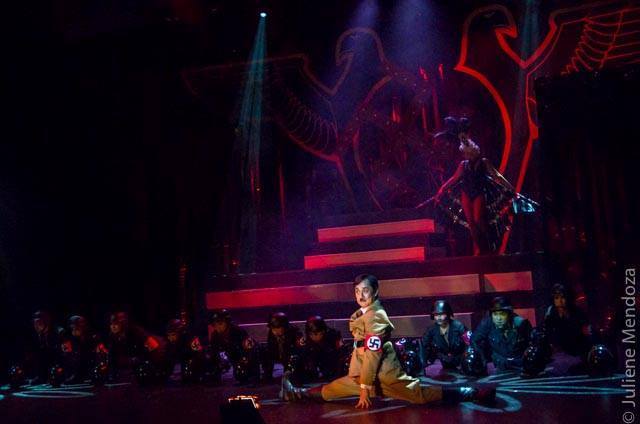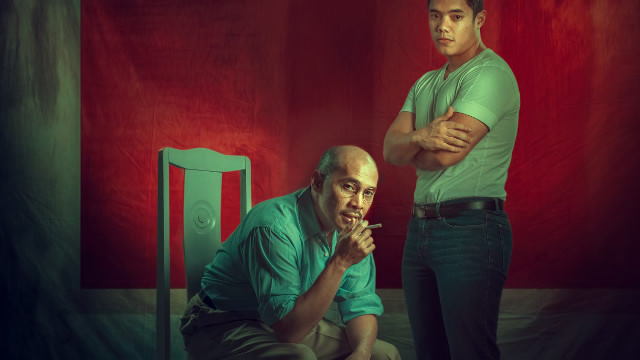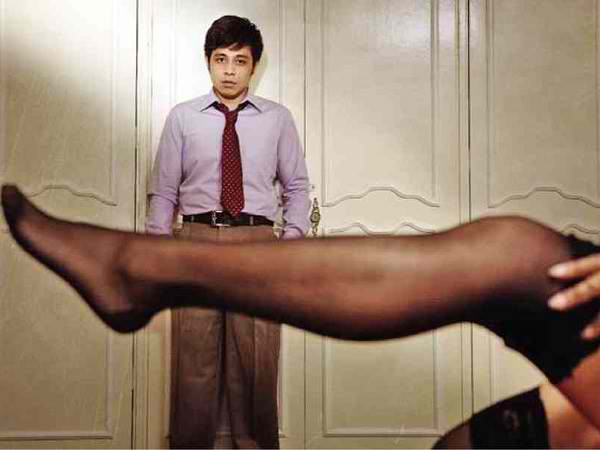down to my last seven highs and lows of Pinoy theater in 2013 (counting Maxie The Musical to have been the sixth in the last installment, Lorenzo the fifth, yes, i might be cheating, haha). i realized that instead of many wonderful productions (there was a lack of it for PETA and Repertory Philippines, unlike in 2012), there were performances this year that were just wonderful, some that saved productions from utter ruin.
but also there’s having watched all of Virgin Labfest 2013 (yes, ang sipag!), comics artist and writer Carlo Vergara’s theatrical debut in Kung Paano Ako Naging Leading Lady, Trumpets’ return with Bluebird of Happiness, and the birth of Red Turnip Theater, all of which excite little ol’ un-jaded me.
so maybe here’s the last eight of my 13 for 2013 Pinoy theater round-up. first with two much-celebrated, but really quite tragic productions of the year, and two smaller productions that could, but were barely reviewed and assessed.
low: a National Artistic fail in San Andres B. anyare Rio Alma? there was nothing in San Andres B. that was beautiful or graceful, and really, one had to wonder why it was staged at all with such a flimsy concept and story. but of course it would be staged! it was written by National Artist Virgilio Almario! but being national artist for literature does not mean we know to write a play or musical. in the case of San Andres B., the take on Andres Bonifacio as saint, something that we are being told was borne of his struggle given all the voices in his head, was just ill-conceived. to have those voices represent the nation via the three women wearing the colors of the Philippine flag speaking in scary voices, and three men who seem to be the evil conscience and later colonizers of the nation, was trite and old. it was also all too Regal Films for comfort. and no, not Chino Toledo, not Floy Quintos, could save this play that had nothing going for it. it reminds of how at the heart of a theatrical production is a playwright and librettist who knows his shitz. Rio Alma, National Artist for Literature, ain’t one of them.
 high: Carlo Vergara crosses over. because one need not be National Artist either to go from one kind of writing to another, and in the case of Carlo Vergara of ZsaZsa Zaturrnah fame, it was from comics to stage. his Virgin Labfest comedy Kung Paano Ako Naging Leading Lady was concise and swiftly told, like watching a story unfold in panel after panel of a well-written comic book. the thing was of course that he was working with stage, and speaking of a team of superheroes based in Manila who go out to save the world, this one act play could’ve suffered the limitations of space and time were it not well-thought-out. but with set designer Tuxqs Rutaquio and director Chris Martinez, this play was everything it needed to be: laugh-out-loud feet-stomping funny, a touching story of sisters limited and transformed by the needs and desires of the social class they belong to, fantastic and out-of-this-world even as it is riddled with everything that is real to us in this context. and so the superhero Leading Man happens upon these sisters, and their lives are transformed. this aches for a sequel really, but maybe Vergara is correct: there are five more superheroes to create stories for: Madre De Dios, Windang Woman, Bazookaman, Nena Babushka, and Popoy Pusakal. we should all be so lucky to get five more one-act plays out of him.
high: Carlo Vergara crosses over. because one need not be National Artist either to go from one kind of writing to another, and in the case of Carlo Vergara of ZsaZsa Zaturrnah fame, it was from comics to stage. his Virgin Labfest comedy Kung Paano Ako Naging Leading Lady was concise and swiftly told, like watching a story unfold in panel after panel of a well-written comic book. the thing was of course that he was working with stage, and speaking of a team of superheroes based in Manila who go out to save the world, this one act play could’ve suffered the limitations of space and time were it not well-thought-out. but with set designer Tuxqs Rutaquio and director Chris Martinez, this play was everything it needed to be: laugh-out-loud feet-stomping funny, a touching story of sisters limited and transformed by the needs and desires of the social class they belong to, fantastic and out-of-this-world even as it is riddled with everything that is real to us in this context. and so the superhero Leading Man happens upon these sisters, and their lives are transformed. this aches for a sequel really, but maybe Vergara is correct: there are five more superheroes to create stories for: Madre De Dios, Windang Woman, Bazookaman, Nena Babushka, and Popoy Pusakal. we should all be so lucky to get five more one-act plays out of him.
low: Rock Supremo proves a soundtrack does not make a ballet. or any theater production for that matter. certainly there is a way of conceptualizing a theater production from a set of songs — Sa Wakas after all successfuly did it this year with Sugarfree songs. but it is this concept that this production by Ballet Philippines and Rock Ed did not have.
its bigger failing is that it did not know to see this lack, it did not know to admit that it had nothing but some wonderfully written songs about Andres Bonifacio, and choreography and dancing that could interpret these. i tend to think that were they less set on making some grand statement about nationalism and change, were they not dead set on the idea of “contributing” to the discourse on Bonifacio and history beyond these songs, then they would’ve allowed for a better discussion of Bonifacio given just these songs and some interpretative and inventive dance.
instead what we had was a pretend-intelligent discussion about Bonifacio, one that had barely anything to do with these original songs. instead we were treated to Paul Morales going all out acting as narrator, speaking to us like we’re in the land of Batibot. instead what we are given is a hodge-podge of moments in Bonifacio’s life, where truthfulness is unclear and seems to be beside the point. yet we were also being spoon-fed some truth about nationalism throughout the stretch of this production.
without music and dancing, this would’ve been an utter failure. actually, no. even with the music and dancing, Rock Supremo as a theater production was one supreme failure. music ain’t everything, but they should’ve known that before kicking this project off.
 high: Sa Wakas shows ’em all how it’s done. a musical like Sa Wakas was doomed to fail. working with the now defunct band Sugarfree’s body of work, this production at the onset was also taking a jab at the stories we have created through these songs — we are wont to be unkind. we are also wont to be critical, because it is too easy to work with these songs and heighten the drama and cheesiness in them, instead of working with the nuances of the stories that Ebe Dancel (as frontman of Sugarfree and songwriter) tells. ah, but creator Charissa Ann Pammit and librettists Andrei Pamintuan and Marian Abuan knew exactly how to tell a love story through these songs, without sacrificing one for the other.
high: Sa Wakas shows ’em all how it’s done. a musical like Sa Wakas was doomed to fail. working with the now defunct band Sugarfree’s body of work, this production at the onset was also taking a jab at the stories we have created through these songs — we are wont to be unkind. we are also wont to be critical, because it is too easy to work with these songs and heighten the drama and cheesiness in them, instead of working with the nuances of the stories that Ebe Dancel (as frontman of Sugarfree and songwriter) tells. ah, but creator Charissa Ann Pammit and librettists Andrei Pamintuan and Marian Abuan knew exactly how to tell a love story through these songs, without sacrificing one for the other.
that is, Sa Wakas told the love story backwards, which also forced spectatorship to suspend judgment on characters and their motivations, and allowed for compassion for all three characters in what turned out to be the most conventional love triangle ever. and this is the thing: this love story is archetypal, but Pamintuan (as director and librettist) and Abuan knew to work not just with unconventional storytelling, but more importantly with unapologetic contemporariness. which is also to say the moments here might seem cliche, but without the chronology to frame it, these become independent conversations, capsules of time spent, by two people who are getting to know each other better and better, towards the beginning or the end of a relationship. that these conversations were real, riddled with references to contemporary pop culture, just made it even more enjoyable to watch. it is to the credit of this production that one did not know which Sugarfree song would be used at any given time, and by the time “Burnout” was sung, it was not so much expected, as it seemed to be a relief for all of us watching the story unfold.
the Sugarfree songs as such did not seem to be the basis of Sa Wakas, as it seemed to have been a story that had this soundtrack of songs. the musical direction by EJ Yatco afforded these original songs an amount of respect, where each one became an anthem for a particular moment, if not was about a particular conversation. this cast was pretty great too, despite what seemed to be unbalanced sound. Victor Robinson III as Topper was the right balance of certain and confused, of rebel-without-clear-cause. Caissa Borromeo as the ambitious doctor Lexi with dreams beyond the relationship with Topper was rightfully detached and distant, as she was clinging onto the possibility of a future. it was Kyla Rivera as artist and writer Gabbie though who would be the most wonderful character here, whose struggle was perfectly portrayed not to have been about right and wrong, but just about how one feels and what one must do. this character might be the most powerful, because decisive and real, contemporary Pinay character we’ve seen in culture in a long time.
this is the other gift of Sa Wakas. it is able to take that moral compass we always use to measure love and romance against, and render it irrelevant. in that sense it portrays love and becoming between two people to be about nothing but.
high: Bart Guingona. in 2013, Guingona did artist Rothko in Necessary Theater’s Red and Larry in Red Turnip Theater‘s Closer. he was not only en pointe, as he was in sync with these productions. particularly for Red, doing double-duty as director allowed for probably the most succinct, most complete, performance from any theater actor all of 2013. it is no different from how wonderfully that whole cast of Repertory Philippines’ Next Fall — of which Guingona was in the lead — resonated in 2012.
but Guingona’s take on Rothko, both as actor and director, worked because it was as simple as it needed to be, as quiet and introspective, as crazed artistic and insecure. the whole production was balanced, the hysteria and paranoia working seamlessly with the creative genius that was at the heart of the production. it helped of course that Guingona’s Rothko was up against the fictional apprentice Ken played by Joaquin Valdes, who was quite the revelation, his character’s growing disillusionment about art and the world something that happened as slowly as it must, internal and emotional as those changes are.
in Closer, Guingona’s take on Larry was also perfectly execrable and oppressive, even as it is clear that at the heart of this character is pain and insecurity and loneliness. in Guingona, the years seem to have only made him better, and the ability at transformation is extraordinary: one forgets completely that it is actor-playing-a-role. Guingona is Rothko, as he is Larry, and i wonder if Guingona is but the character those two other people play.
high: Audie Gemora. in two productions this year Gemora outdid everybody else on the theater stage, by showing them that half the time one earns the swagger for cross-dressing, and the other half one must know nuance in performance. in Repertory Philippines’ No Way To Treat A Lady Gemora potrayed the serial killer Kit with a calm that only the more learned would know to employ. while the comedy was borne of the role-playing and costume changes that Kit needed to do to get to his prey, Gemora also knew to sit and stare into nothingness with a glint in his eye that spoke of Kit’s evil. as such it was truly a balance between the comedy that is the point of this production, and the diabolical psyche that is at the heart of this character’s being. Gemora did it all without missing a beat.

as Roger De Bris in Repertory Philippines’ The Producers, Gemora was just as fun to watch. De Bris, the gay cross-dressing director who takes on the duo Max Bialystock and Leo Bloom’s dream of a flop “Springtime for Hitler,” ends up playing the lead of the most horribly politically incorrect play to ever be staged. Gemora’s De Bris needed to see the production within this production through to its logical campiness and flamboyance, so that its political incorrectness might be erased by the idea of satire. Gemora ran with it, and how! without missing a beat, conscious of the layering of roles that this character demands, and fitting both those portrayals to a tee — one more crazed and exaggerated than the other.
Gemora’s Trumpets would also stage Bluebird of Happiness this year, a wonderfully-written and staged original Filipino musical. this would seem to be Gemora’s year, really. we should all be so lucky.
hope: Reb Atadero and Nicolo Magno. the parallelism is a strange one for sure, and might seem a bit lopsided but these two remind me each time i see them on stage that there is young upcoming talent for Pinoy theater still, in English and Filipino, musical and otherwise, and everything else in between.
in 2012 Atadero had the opportunity to do the lead in Woman In Black, opposite theater veteran Jeremy Domingo. surviving the latter was a feat in itself, but also Atadero held his own, playing the actor of the play within the play, one where he had to live the experiences of the older Arthur Kipps (Domingo), and his experience in Eel Marsh House fixing the papers of one Mrs. Drablow. this production worked mostly with an empty stage, that had Atadero speaking to only a voice — Domingo’s — giving direction and providing narration. he was outstanding.
as he was in 2013’s The Graduate by Repertory Philippines. riddled with controversy because it was announced that Cherie Gil would play Mrs. Robinson opposite Atadero’s Benjamin; and because Pinky Marquez was certainly far from being our imagined Mrs. Robinson, Atadero carried much of this play on his shoulders, and he did so with chutzpah. it reminded me again of his performance in Woman In Black, but also it revealed enough maturity in this actor to actually do the innocence and directionless, the pointlessness and confusion, that are in the character of Benjamin, all the while keeping the audience’s sympathy. Atadero’s comedic timing also doesn’t miss.
 it is this kind of maturity as well that is in Nicolo Magno, who kicked off the year with Baltog in Ibalong, and revealed the ability at a graceful machismo, one that exists in many of our local epics and myths, but which is rarely portrayed succinctly on stage and elsewhere. in Der Kaufmann, Magno’s Bassanio came to life in its seamless shifts between abusive military officer and compassionate friend to Antonio, something that was brilliant in itself. i think though that Magno’s best performance just might be his take on Orestes in Tanghalang Ateneo’s Ang Oresteyas. a consciously heavy and violent adaptation of the Aeschylus original by Jay Crisostomo IV, Magno’s Orestes was memorable because the material used his aformentioned macho gracefulness, his litheness onstage allowing for the choreography to work, and the story to be swiftly told. Magno’s Orestes was also strong in his crisis, even as he was confused about his righteousness, even more so about the justice that he deserved.
it is this kind of maturity as well that is in Nicolo Magno, who kicked off the year with Baltog in Ibalong, and revealed the ability at a graceful machismo, one that exists in many of our local epics and myths, but which is rarely portrayed succinctly on stage and elsewhere. in Der Kaufmann, Magno’s Bassanio came to life in its seamless shifts between abusive military officer and compassionate friend to Antonio, something that was brilliant in itself. i think though that Magno’s best performance just might be his take on Orestes in Tanghalang Ateneo’s Ang Oresteyas. a consciously heavy and violent adaptation of the Aeschylus original by Jay Crisostomo IV, Magno’s Orestes was memorable because the material used his aformentioned macho gracefulness, his litheness onstage allowing for the choreography to work, and the story to be swiftly told. Magno’s Orestes was also strong in his crisis, even as he was confused about his righteousness, even more so about the justice that he deserved.
Atadero obviously ain’t getting as many lead roles as Magno, but in the past year Atadero was in ensemble roles in musicals like They’re Playing Our Song and Grease, where he proves a comic timing that stole both shows. Magno meanwhile, as a member of the Actor’s Company of Tanghalang Pilipino, seems to be on a roll.

hope: Regina De Vera and Opaline Santos. in the past year, Opaline Santos floored me in two productions: in Kudeta! Kudeta! staged during Virgin Labfest, and in Ang Oresteyas by Tanghalang Ateneo. in the latter Santos was the prophetess Kasandra, capturing the eerie presence of one who knows far more than anyone on that dark violent stage, but also someone who is silenced and oppressed by this same context within which she exists. in Santos’s hands, Kasandra was both prophet but also portents of things to come, her eeriness both wicked and wretched. in Kudeta! Kudeta! Santos was also the speaker of craziness and truth, where she is both rebel and angel, without falling easily between good and evil. here Santos balances the credibility of holding the truths of this narrative, and the undoing of these truths given a craziness that is complex and complete.
Regina De Vera seems to be that actress you can depend on to carry a production on her shoulders and shine no matter how horrid the material — case in point, being one of the women’s / nation’s / flag’s voices in San Andres B. but too, as she was brilliant in Walang Kukurap in the role of the kolehiyala trapped in the corruption of local government and politics that her family was embroiled, this year she shone in the role of the older sister in Sandosenang Sapatos, doing kindness and quiet sadness like no other. in contrast, her take on the reconfigured Portia in Der Kaufmann was quite a show. a heightened but controlled take on the powerful woman who is in control of the world beneath her, who is critical to its unfolding unbeknownst to the ones who are part of the story. eyes wide and nostrils flaring, the exaggeration worked to the advantage of this production, as it was a measure of how De Vera’s in a class all her own given her generation.
and i’m done, that’s really more than 13, haha, but this is the wonder of writing in one’s own space. it’s not just the absence of a word limit, but more importantly the freedom to think bigger and better about things. i wish for the theater world better-written and well-thought-out reviews in 2014, where it is not just about churning out a review because of a deadline, as it is about engaging with theater productions as works of culture, as works that are alive, and which continue to live.
cheers to Pinoy theater in 2013! 2012 and 2011, too! you guys have given me a great time, even as i know very few of you, and there are a handful i’ve become friends with. i’ve said it on Facebook and i say it again here: the theater sector has proven itself open to criticism, more than any other sector of the arts. that has made doing reviews valuable (at least to me), and it is why writing reviews should be painstaking work.
i cannot wait to hear you all roar in 2014! :)
note: all photos and posters are from official sites and FB pages of the theater production companies. :)



Thank you so very much!
thank you, Sir Audie, for performances that were the brighter moments of an otherwise difficult year for nation. :) cheers!
[…] RadikalChick Author Katrina Stuart Santiago also included this FringeMNL collaboration as one of “Pinoy theater’s highs” of […]
[…] RadikalChick Author Katrina Stuart Santiago also included this FringeMNL collaboration as one of “Pinoy theater’s highs” of […]
[…] Lauchengco-Yulo and Jett Pangan for Next To Normal, among many others that happen for Atlantis. Sa Wakas‘s musical direction just because it was by an independent production […]